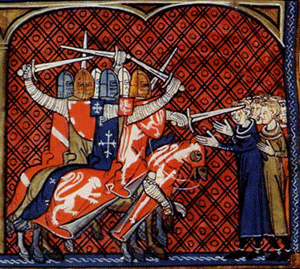Set against the backdrop of Edward I "The Hammer of Scots", Scotland's freedom was in danger!
Robert the Bruce, known as the Good King of Scots was born 11 July, 1274 at Turnberry Castle, Scotland. When Alexander III, King of Scots, died unexpectedly in 1296, without an heir, young Margaret of Norway, Alexander’s granddaughter was invited to take the throne. She departed Norway and, on her voyage to Scotland, fell ill and died. King Edward I was asked to intervene and help choose from the remaining eligible claimants.
Three competitors stepped forward to lay claim to the throne:
•John Balliol
•John Comyn
•Robert the Bruce
Edward installed the weak and wavering John Balliol, receiving homage from him as a vassal of England that next Christmas, to the disgust of the Scottish nobles. After John Balliol abdicated the throne in 1296, Robert realized that if the country wasn’t unified behind one King, England would soon take the tiny country to itself.
Exasperated, Robert approached John Comyn with an offer of truce on 1305. "Help me to be King and I will give you my estates, or give me your estates and I will help you." John preferred the Crown, and they made an exchange of signed and sealed documents to that effect. Later John Comyn exposed their pact to King Edward. As a result, Robert had to flee England for his life.
Robert convinced John Comyn to meet him at Greyfriars Church in Scotland. John and Robert withdrew to the high alter at which Robert confronted John with his treachery. They argued violently. Both drew their daggers, and Robert struck the first blow, leaving John wounded at the alter, but alive.
Joining Bruce's followers outside, Roger Kirkpatrick saw Bruce's agitation and the blood on his clothes. Robert simply replied,” I doubt that I have slain Red Comyn."
"Do you doubt?" asked Kirkpatrick, "Then I will make sure!" He entered the church and dispatched Comyn.
Most historians have called this the murder of John Comyn, but the circumstances seem to raise questions. With Bruce ranking as one of the three best knights in Europe, surely he could have finished Comyn himself if he had chosen to. He certainly wouldn't have left him wounded if he had wanted the man dead. Weight must also be given to their temperaments as well. Comyn was known for his fiery rage and Robert for his generosity to friends and supporters, but more importantly, his mercy toward his enemies.
Whether Robert was defending himself or not, the incident left Bruce with only two choices. He could run to Norway and seek asylum at his sister's court, or hazard all in the final pursuit of the Throne of Scotland. During those years of fighting for Scotland’s freedom, Bruce’s wife and daughter were taken prisoner, and held for 12 years by the English, and several of his brothers were killed. This was a deplorable situation for a man who frequently offered forgiveness to his captives, and even a place in his own army.
Hiding in a cave one rainy afternoon, disappointment and weariness taking their toll, he saw a small spider struggling to build a web. When finally the spider reached its mark and attached its web, Robert fashioned the famous phrase, "If at first you don't succeed, try, try again."
On a gentle hill near Stirling Castle,in June of 1314, at Bannockburn, he was finally triumphant. With an army numbering about 6,000, he faced Edward's army of more than 20,000. Outnumbered and lacking sophisticated weaponry, he none-the-less led that tiny army to an unexpected and glorious victory; he would be Scotland’s hero for many years to come.























